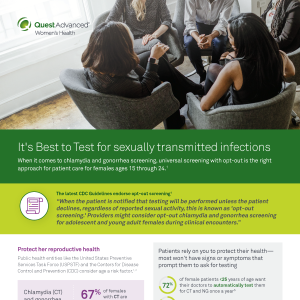It's Best to Test for sexually transmitted infections
Sexually transmitted infections (STIs) are on the rise for the 6th year in a row, yet many STIs are undetected as people often do not have symptoms.1,2 Patients with asymptomatic infections do not seek testing, leading to increased transmission and complications in females, yet screening rates remain low.3

Americans have an STI1,4*
*On any given day in 2018.
Universal screening with opt-out for chlamydia and gonorrhea is the right approach for patient care
Universal screening with opt-out can help ensure that your female patients ages 15-24 can be identified and treated, thereby reducing their risk of developing pelvic inflammatory disease and ultimately protecting their fertility.
females each year become infertile due to untreated STIs that lead to pelvic inflammatory disease (PID)5,6


Universal screening with opt-out for CT/NG
Notify ALL female patients ages 15-24 that CT/NG screening is included in their annual visits unless specifically declined8
Your adolescent and young adult female patients need greater protection

As of 2018, 1 in 2 STIs was acquired by people under the age 254

More than half of females ages 15–24 are reluctant to bring up STIs with their provider9

Most female patients <25 years of age want their doctors to automatically test them for CT and NG once a year10
Universal screening with opt-out makes it easier to protect your patients
From the 2021 CDC Guidelines8
When the patient is notified that testing will be performed unless the patient declines, regardless of reported sexual activity, this is known as ‘opt-out screening.’ Providers might consider opt-out chlamydia and gonorrhea screening for adolescent and young adult females during clinical encounters.
Cost-effectiveness analyses indicate that opt-out chlamydia screening among adolescent and young adult females might:
• Substantially increase screening
• Be cost-saving
• Identify infections among patients who do not disclose sexual behavior
Universal screening with opt-out for females 15-24 can decrease CT
prevalence by more than 55%11
Commit to universal screening with opt-out for CT/NG for your adolescent and young-adult patients
Universal screening with opt-out can be integrated into OBGYN practices without disrupting the practice workflow. By increasing screening, you can help ensure that your at-risk patients can be identified and treated earlier—reducing their risk of developing PID and ultimately protecting their fertility.

Eases pressure on providers to identify sexual activity among adolescent and young adult patients
May help patients feel less judged or singled out
Can help in conversations with parents who think their child may have been screened due to risk
Is usually available to patients at $0 copay12
As part of mandatory reporting requirements to identify potential abuse, when testing minors under the age of consent, healthcare professionals may be required in certain jurisdictions to report positive results of sexually transmitted disease testing to authorities.
Access resources and insights to help you integrate universal screening with opt-out

Recognizing high-risk behaviors
in your female patients—and screening accordingly.
Know which patients are considered high-risk
Both the Centers for Disease Control and Prevention (CDC) and US Preventive Services Task Force (USPSTF) recommended screening for chlamydia and gonorrhea in sexually active women ages 25 and older if at increased risk for infection.8,13 Trichomonas screening should also be considered.
USPSTF identifies risk factors as13:
- Inconsistent condom use among patients not in mutually monogamous relationships
- Multiple sex partners
- Previous or coexisting STI
- A new sex partner
- A sex partner with concurrent partners
- Exchanging sex for money or drugs
Asking the right questions to better assess risk
Do you use condoms: never, sometimes, or always?
In the past 12 months, how many partners have you had sex with?
Have you ever had an STI?
Has a partner had an STI?
Protect your patients today.
Contact your Quest Diagnostics representative about how you can make universal screening with opt-out the standard of care in your practice.
Contact UsOrdering the right test at the right time
Screening for STIs is recommended for women at all stages of their lives. The intuitive tables below can help guide your discussions for patient-focused testing recommendations.
Test code 11363
Test codes 19550, 90521
Test code 11363
- Annual screening is recommended for females ages 15-248
- Screening is recommended for women 25 and over at increased risk8a
-
Panel components can be ordered separately:
- Test code 11361—Chlamydia trachomatis RNA, TMA, Urogenital
- Test code 11362—Neisseria gonorrhoeae RNA, TMA, Urogenital
Test codes 19550, 90521
- Screening for Trichomonas vaginalis should be performed on women seeking care for vaginal discharge8
- Screening might be considered for women receiving care in high-prevalence settings and for asymptomatic persons at increased riska for infection
- The use of highly sensitive and specific tests, such as NAAT, are recommended over less-sensitive methods including wet-mount microscopy8b
Test code 11363
Test code 11363
Test codes 19550, 90521
Test code 11363
- All pregnant women aged <25 years or older women at increased risk for infection should be screened during their first prenatal visits8
- Those aged <25 years and those at increased riska for chlamydia should be retested during their third trimester8
- Those found to have chlamydial infection should have a test-of-cure (preferably by NAAT) 3 to 4 weeks after treatment and retested at 3 months8
Test code 11363
- All pregnant women aged <25 years and older women at increased riska for gonorrhea should be screened at their first prenatal visits8
- Women found to have gonococcal infection should be treated immediately and retested within 3 months8
- Those who remain at high riska for gonococcal infection should be retested during the third trimester8
Test codes 19550, 90521
- Women who report symptoms should be evaluated and treated appropriately
- Evidence does not support routine screening for Trichomonas vaginalis in asymptomatic pregnant women
Test code 11363
Test codes 19550, 90521
Test code 11363
- For sexually active individuals, screen at first HIV evaluation, and at least annually thereafter8
-
Panel components can be ordered separately:
- Test code 11361—Chlamydia trachomatis RNA, TMA, Urogenital
- Test code 11362—Neisseria gonorrhoeae RNA, TMA, Urogenital
- Specific testing includes NAAT for C trachomatis at the anatomic site of exposure as the preferred approach
Test codes 19550, 90521
- Recommended for sexually active women at entry to care and at least annually thereafter8
Test code 11363
Test code 11363
Test codes 19550, 90521
Test code 11363
- Women and men should be retested approximately 3 months after chlamydia treatment8c
- If retesting at 3 months is not possible, you should retest whenever your patient next receives medical care in the 12 months following the initial treatment8
Test code 11363
- Patients with symptoms that persist after treatment should be evaluated by culture for gonorrhea and for antimicrobial susceptibility8
- Clinicians should advise patients with gonorrhea to be retested 3 months after treatment or when they next seek medical care within the following 12 months8
Test codes 19550, 90521
- Retesting for Trichomonas vaginalis is recommended for all sexually active women within 3 months following initial treatment regardless of whether they believe their sex partners were treated8
a People with increased risk are women who have had a history of sexually transmitted diseases (STDs), exchange sex for payment, or use injection drugs; and men and women with a new sex partner, more than 1 sex partner, a sex partner with concurrent partners, or a sex partner who has a sexually transmitted infection.
b When highly sensitive testing (eg, nucleic acid amplification test [NAAT]) is not feasible, a testing algorithm (eg, wet mount first, followed by NAAT if negative) can improve diagnostic sensitivity.
c The use of chlamydial NAATs at <3 weeks after completion of therapy is not recommended because the continued presence of nonviable organisms can lead to false-positive results.9
These helpful resources can provide additional information and guidelines:
References:
- Center for Disease Control and Prevention (CDC). STI prevalence, incidence, and cost estimate. https://www.cdc.gov/std/statistics/prevalence-2020-at-a-glance.htm Accessed March 14, 2022.
- Office of Disease Prevention and Health Promotion. Sexually transmitted diseases. HealthyPeople.gov website. Updated Fall/Winter 2021. Accessed March 12, 2022. https://www.healthypeople.gov/2020/topics-objectives/topic/sexually-transmitted-diseases
- Contemporary OB/GYN. Chlamydia screening in the new wave of COVID-19. Updated July 1, 2021. Accessed March 14, 2022. https://www.contemporaryobgyn.net/view/chlamydia-screening-post-covid-19
- CDC estimates 1 in 5 people in the U.S. have a sexually transmitted infection. Centers for Disease Control and Prevention. Published January 25, 2021. Accessed March 12, 2022. https://www.cdc.gov/media/releases/2021/p0125-sexualy-transmitted-infection.html
- Detels R, Green AM, Klausner JD, et al. The incidence and correlates of symptomatic and asymptomatic Chlamydia trachomatis and Neisseria gonorrhoeae infections in selected populations in five countries. Sex Transm Dis. 2011;38(6):503-509.
- CDC. CDC fact sheet: how STDs impact women differently from men. Accessed December 14, 2021. https://www.cdc.gov/nchhstp/newsroom/docs/factsheets/stds-women.pdf
- CDC. CDC fact sheet: Pelvic inflammatory disease (PID). Updated January 27, 2017. Accessed September 14, 2021. https://www.cdc.gov/std/pid/stdfact-pid-detailed.htm
- CDC. Sexually Transmitted Infections Treatment Guidelines, 2021. Accessed March 14, 2022. https://www.cdc.gov/std/treatment-guidelines/STI-Guidelines-2021.pdf
- CDC. CDC fact sheet: information for teens and young adults: staying healthy and preventing STDs. Accessed March 14, 2022. https://www.cdc.gov/std/life-stages-populations/stdfact-teens.htm
- Quest Diagnostics. Universal STI testing research among young women and moms: topline report. December 2017.
- Owusu-Edusei K Jr, Hoover KW, Gift TL. Cost-effectiveness of opt-out chlamydia testing for high-risk young women in the US. Am J Prev Med. 2016;51(2):216-224. doi:10.1016/j.amepre.2016.01.007
- CDC. Sexually transmitted disease preventive services coverage. Accessed March 14, 2022. https://www.cdc.gov/nchhstp/preventionthroughhealthcare/preventiveservices/std.htm
- Davidson KW, Barry MJ, Mangione CM, et al; US Preventive Services Task Force. Screening for chlamydia and gonorrhea: US Preventive Services Task Force Recommendation Statement. JAMA. 2021;326(10):949-956. doi:10.1001/jama.2021.14081
Test codes may vary by location. Please contact your local laboratory for more information.










